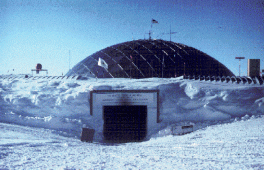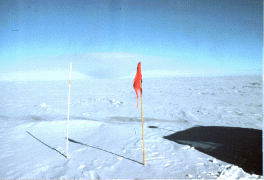South Pole
Antarctica
Ice Core Studies

A 101-m core drilled in 1974 at South Pole Station (90oS; 2800 m a.s.l.) was cut into 5218 samples for microparticle concentration measurements used to establish a 911-year record (Mosley-Thompson and Thompson, 1982). In addition, the core was cut into 1024 samples for δ18O analyses made at the University of Copenhagen. As the δ18O samples were cut to approximate annual increments they did not contribute to the establishment of the time scale which is based solely upon seasonal variations in dust concentrations. The estimated accuracy of the time scale is ± 90 years at 911 yr.B.P.
The South Pole and Siple records of dust and δ18O reveal an anti-phase relationship between atmospheric conditions over the high East Antarctic Plateau and the Antarctic Peninsula area. During cold and dusty periods over East Antarctica, conditions are warmer and the atmosphere is less dusty in the Peninsula region. High resolution records from central West Antarctica are as yet unavailable to determine whether the climate in this region is synchronous with that over East Antarctica, or that in the Peninsula region, or whether it is totally different. High resolution records from central West Antarctica should be a high priority for future antarctic drilling plans.
Mosley-Thompson, E. and L. G. Thompson. Nine centuries of microparticle deposition at the South Pole. Quaternary Research, 17(1), pp. 1-13. PDF
Mosley-Thompson, E., P.D. Kruss, L.G. Thompson, M. Pourchet and P. Grootes. Snow stratigraphic record at South Pole: potential for paleoclimatic reconstruction. Annals of Glaciology, 7, 26-33. PDF
Mosley-Thompson, E., K.R. Mountain and J.F. Paskievitch. 1986. Paleoclimatic ice core program at Siple Station. Antarctic Journal of the U.S., XVI(5), 115-117. PDF
Palais, J.M., P.R. Kyle, E. Mosley-Thompson, and E. Thomas. Correlation of a 3,200 year old tephra in ice cores from Vostok and South Pole Stations, Antarctica. Geophysical Research Letters, 14(8), 804-807. PDF
Snow Accumulation Studies

A review of the 37-year history of net accumulation measurements at the geographic South Pole obtained by numerous investigators and a variety of techniques was recently completed, The results indicatie that annual net snow accumulation has increased in the vicinity of South Pole Station (SPS) by more than 20% in the last two decades. The records were examined for evidence of a 'station effect' and it has been concluded that not all of the observed increase can be attributed to snow drift associated with the presence of the station. As none of the older accumulation networks have been preserved, a new accumulation network has been established and to provide a basis for the permanent, systematic monitoring of the 'natural' accumulation at SPS.
In November, 1992 an array of 235 poles in six lines, each 20 km long, centered on the SPS was installed for systematic, long-term monitoring of net accumulation. The network was established using standard surveying techniques which were verified using GPS (global positioning system). The lines are centered on the six grid directions (45o, 110o, 170o, 230o, 290o, and 350o), extend 20 km from the station, and contain poles (like that shown in the photograph) spaced 500 ± 1 m apart. When they were installed all pole heights (from the top of pole to the original snow surface) were 182.88 cm and all pole lengths were identical. The accumulation history from 1958 to 1994 are shown in the figure.
Mosley-Thompson, E., L.G. Thompson, J.F. Paskievitch, M. Pourchet, A.J. Gow, M.E. Davis, and J. Kleinman. Recent increase in South Pole snow accumulation. Annals of Glaciology, 21, 131-138. PDF

